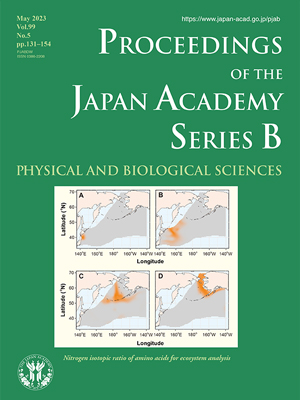About the Cover
Vol. 99 No. 5 (2023)
The concept of the stable isotope (SI) studies arises due to the unique characteristics of “SI-ratios,” which are the interdisciplinary parameters for elementary process and ecosystem dynamics of biophilic elements, and for a dynamic chemical finger print of biogenic substances.
The abundance of 15N in amino acids has been recently utilized to further elucidate the various macroscale processes such as food web dynamics. The kinetic isotope effects that enrich 15N (relative to 14N) in certain amino acids associated with the metabolic processes has been observed and demonstrated in natural ecosystem and laboratory experiments, respectively. In trophic processes, “trophic amino acids” such as glutamic acid that significantly enrich 15N, and “source amino acids” such as phenylalanine and methionine show limited 15N enrichment. Through various applications, the principles of the method have shown to operate well and disentangle complex food webs and relevant concerns. Applications include food chain length estimation, nitrogen resource assessment, tracking fish migration, and reconstruction of paleodiet.
One of the uses of nitrogen isotopic ratio (15N/14N) of phenylalanine that reflects the base of the food chain is its application to marine biological samples through “isoscape” (i.e., isotope + landscape) for tracking fish migration in time and space. This approach was utilized to reconstruct the long-distance migration route of chum salmon (Oncorhynchus keta) in the northern North Pacific. The migration areas of chum salmon along growth stages (A to D) depicted in the cover illustration were estimated by matching nitrogen isotopic ratio of phenylalanine recorded in centrifugal vertebral growth rings to the North Pacific nitrogen isoscape through a statistical model (originally published in Matsubayashi et al., Ecol. Lett. 23, 881 (2020)). The results reveal that the chum salmon born in Japanese rivers gather at the later stage of their growth on the continental shelf in the eastern Bering Sea where they mature supported by high biological productivity, after roaming the northwest Pacific Ocean for a year or two.
The development of the methodology and applications has been led by N. Ohkouchi and group, who review the principles of this compound-specific isotopic approach through its applications to the ecological issues over the last two decades (see the article in this issue, pp. 131-154).
Eitaro Wada
Member of the Japan Academy




